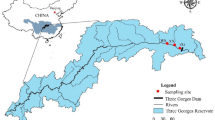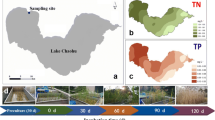Abstract
Purpose
To study the effects of snail (Bellamya aeruginosa) bioturbation on phosphorus (P) mobility in sediment and the relevant mechanisms behind them.
Materials and method
A microcosm simulation experiment was carried out at millimeter resolution with an 89 days culture of homogeneous sediments. High-resolution dialysis (HR-Peeper) and diffusive gradient in thin films (DGT) techniques were utilized to simultaneously acquire the vertical distribution of soluble and labile P/iron (Fe) in bioturbation sediments.
Results and discussion
Snail bioturbation significantly enhanced soluble reactive P (SRP) and labile P concentrations, with the maximum increment to 306% and 1133% of the control sediments within the influence depths from 0 to − 30 mm and to − 20 mm, respectively. The P fluxes released from the sediment–water interfaces in snail treatments were correspondingly enhanced with the maximum increments to 218% of the control. Also, snail bioturbation significantly enhanced the soluble Fe(II) and labile Fe concentrations by maximum increment of 218% and 199% of the control within 0 to −24 mm and − 19 mm, respectively.
Conclusions
The high correlation between soluble/labile P and Fe suggested that P release from the sediment under snail bioturbation was due to the reduction and dissolution of Fe(III) oxyhydroxide.





Similar content being viewed by others
References
Andersson G, Granéli W, Stenson J (1988) The influence of animals on phosphorus cycling in lake ecosystems. Phosphorus in Freshwater Ecosystems. Springer, Dordrecht, pp 267–284
Carpenter SR (2008) Phosphorus control is critical to mitigating eutrophication. Proc Natl Acad Sci U S A 105(32):11039–11040
Chen CY (1975) On ecological distributions and population densities of mollusca in lake tung-hu,wuchang. Shuisheng Shengwu Xuebao 3:371–379 (in Chinese with an English abstract)
Chen M, Ding S, Li L et al (2015) Iron-coupled inactivation of phosphorus in sediments by macrozoobenthos (chironomid larvae) bioturbation: evidences from high-resolution dynamic measurements. Environ Pollut 204:241–247
Chen M, Ding S, Liu L, Xu D, Gong M, Tang H, Zhang C (2016) Kinetics of phosphorus release from sediments and its relationship with iron speciation influenced by the mussel (Corbicula fluminea) bioturbation. Sci Total Environ 542:833–840
Conley DJ, Paerl HW, Howarth RW, Boesch DF, Seitzinger SP, Havens KE, Lancelot C, Likens GE (2009) Controlling eutrophication: nitrogen and phosphorus. Science 323(5917):1014–1015
Coveney MF, Lowe EF, Battoe LE et al (2005) Response of a eutrophic, shallow subtropical lake to reduced nutrient loading. Freshw Biol 50(10):1718–1730
Davison W, Zhang H (1994) In situ speciation measurements of trace components in natural waters using thin-film gels. Nature 367(6463):546–548
Davison W, Zhang H, Grime GW (1994) Performance characteristics of gel probes used for measuring the chemistry of pore waters. Environ Sci Technol 28(9):1623–1632
Ding S, Han C, Wang Y, Yao L, Wang Y, Xu D, Sun Q, Williams PN, Zhang C (2015) In situ, high-resolution imaging of labile phosphorus in sediments of a large eutrophic lake. Water Res 74:100–109
Dove A, Chapra SC (2015) Long-term trends of nutrients and trophic response variables for the Great Lakes. Limnol Oceanogr 60(2):696–721
Edmondson WT, Lehman JT (1981) The effect of changes in the nutrient income on the condition of Lake Washington. Limnol Oceanogr 26(1):1–29
Fastner J, Abella S, Litt A et al (2016) Combating cyanobacterial proliferation by avoiding or treating inflows with high P load—experiences from eight case studies. Aquat Ecol 50(3):1–17
Gerino M, Stora G, François-Carcaillet F et al (2003) Macro- invertebrate functional groups in freshwater and marine sediments: a common mechanistic classification. Vie Milieu 53(4):221–232
Haas EMD, Kraak MHS, Koelmans AA et al (2005) The impact of sediment reworking by opportunistic chironomids on specialised mayflies. Freshw Biol 50(5):770–780
Hansen K, Mouridsen S, Kristensen E (1997) The impact of Chironomus plumosus larvae on organic matter decay and nutrient (N, P) exchange in a shallow eutrophic lake sediment following a phytoplankton sedimentation. Hydrobiologia 364(1):65–74
Hietanen S, Laine AO, Lukkari K (2007) The complex effects of the invasive polychaetes Marenzelleria, spp. on benthic nutrient dynamics. J Exp Mar Biol Ecol 352(1):89–102
Holdren GC, Armstrong DE (1980) Factors affecting phosphorus release from intact lake sediment cores. Environ Sci Technol 14(1):79–87
Huser BJ, Futter M, Lee JT, Perniel M (2016) In-lake measures for phosphorus control: the most feasible and cost-effective solution for long-term management of water quality in urban lakes. Water Res 97:142–152
Janssen F, Huettel M, Witte U (2005) Pore-water advection and solute fluxes in permeable marine sediments (II): benthic respiration at three sandy sites with different permeabilities (German bight, North Sea). Limnol Oceanogr 50(3):779–792
Jiang X, Jin X, Yao Y et al (2008) Effects of biological activity, light, temperature and oxygen on phosphorus release processes at the sediment and water interface of Taihu Lake, China. Water Res 42(8–9):2251–2259
Kristensen E, Penhalopes G, Delefosse M et al (2012) What is bioturbation? The need for a precise definition for fauna in aquatic sciences. Mar Ecol Prog Ser 446(1):285–302
Lewandowski J, Hupfer M (2005) Effect of macrozoobenthos on two-dimensional small-scale heterogeneity of pore water phosphorus concentrations in lake sediments: a laboratory study. Limnol Oceanogr 50(4):1106–1118
Lewandowski J, Laskov C, Hupfer M (2007) The relationship between Chironomus plumosus, burrows and the spatial distribution of pore-water phosphate, iron and ammonium in lake sediments. Freshw Biol 52(2):331–343
Martin S, Jens PJ, Erik J (2003) Role of sediment and internal loading of phosphorus in shallow lakes. Hydrobiologia 506-509(1–3):135–145
Mccall PL, Fisher JB (1980) Effects of tubificid oligochaetes on physical and chemical properties of Lake Erie sediments. Aquatic Oligochaete Biology. Springer, Boston, pp 253–317
Mehner T, Diekmann M, Gonsiorczyk T et al (2008) Rapid recovery from eutrophication of a stratified lake by disruption of internal nutrient load. Ecosystems 11(7):1142–1156
Meysman FJ, Middelburg JJ, Heip CH (2006) Bioturbation: a fresh look at Darwin’s last idea. Trends Ecol Evol 21(12):688–695
Mo S, Zhang X, Tang Y et al (2017) Effects of snails, submerged plants and their coexistence on eutrophication in aquatic ecosystems. Knowl Manag Aquat Ecosyst 418:44
Mortimer CH (1941) The exchange of dissolved substances between mud and water in lakes. J Ecol 29:280–329
Murphy J, Riley JP (1962) A modified single solution method for the determination of phosphate in natural waters. Anal Chim Acta 27:31–36
Narf RP (1990) Interactions of Chironomidae and Chaoboridae (Diptera) with aluminum sulfate treated lake sediments. Lake Reservoir Manage 6(1):33–42
Olden JD, Ray L, Mims MC et al (2013) Filtration rates of the non-native Chinese mystery snail (Bellamya chinensis) and potential impacts on microbial commuties. Limnetica 32(1):107–120
Paerl HW, Hall NS, Calandrino ES (2011a) Controlling harmful cyanobacterial blooms in a world experiencing anthropogenic and climatic-induced change. Sci Total Environ 409(10):1739–1745
Paerl HW, Xu H, Mccarthy MJ et al (2011b) Controlling harmful cyanobacterial blooms in a hyper-eutrophic lake (lake Taihu, China): the need for a dual nutrient (N & P) management strategy. Water Res 45(5):1973–1983
Pinowska A (2002) Effects of snail grazing and nutrient release on growth of the macrophytes Ceratophyllum demersum, and Elodea canadensis, and the filamentous green alga Cladophora, sp. Hydrobiologia 479(1–3):83–94
Pu P, Hu W, Yan J et al (1998) A physico-ecological engineering experiment for water treatment in a hypertrophic lake in China. Ecol Eng 10(2):179–190
Qin B, Zhu G, Zhang L et al (2006) Estimation of internal nutrient release in large shallow Lake Taihu, China. Sci China, Ser D: Earth Sci 49(S1):38–50
Qu M, Qu Y, Ren W et al (2010) The mechanism of controlling microcystis bloom by Bellamya aeruginosa. Fudan Xuebao, Ziran Kexueban 3:301–308 (in Chinese with an English abstract)
Ruban V, López-Sánchez JF, Pardo P et al (2001) Harmonized protocol and certified reference material for the determination of extractable contents of phosphorus in freshwater sediments – a synthesis of recent works. Fresenius J Anal Chem 370(2-3):224
Schindler DW, Carpenter SR, Chapra SC, Hecky RE, Orihel DM (2016) Reducing phosphorus to curb lake eutrophication is a success. Environ Sci Technol 50(17):8923–8929
Shull DH (2009) Bioturbation. Encyclopedia of Ocean Sciences 220(4):395–400
Søndergaard M, Jensen JP, Jeppesen E (1999) Internal phosphorus loading in shallow Danish lakes. Hydrobiologia 408-409:145–152
Stookey LL (1970) Ferrozine – a new spectrophotometric reagent for iron. Anal Chem 42(7):779–781
Sun SZ, Zheng ZM, Kai-Hong LU et al (2010) Effects of Bellamya aeruginosa bioturbation on nutrient fluxes across sediment-water interface of algal bloom water body. Shengtaixue Zazhi 29(4):730–734 (in Chinese with an English abstract)
Watzin MC, Miller EB, Shambaugh AD et al (2006) Application of the WHO alert level framework to cyanobacterial monitoring of Lake Champlain, Vermont. Environ Toxicol 21(3):278–288
Welch E, Denniscooke G (1999) Effectiveness and longevity of phosphorus inactivation with alum. Lake Reservoir Manage 15(1):5–27
Xu D, Wu W, Ding S et al (2012) A high-resolution dialysis technique for rapid determination of dissolved reactive phosphate and ferrous iron in pore water of sediments. Sci Total Environ 422(4):245–252
Xu D, Chen Y, Ding S, Sun Q, Wang Y, Zhang C (2013) Diffusive gradients in thin films technique equipped with a mixed binding gel for simultaneous measurements of dissolved reactive phosphorus and dissolved iron. Environ Sci Technol 47(18):10477–10484
Zhang H, Davison W (1995) Performance characteristics of diffusion gradients in thin films for the in situ measurement of trace metals in aqueous solution. Anal Chem 67(19):3391–3400
Zhang L, Gu X, Fan C et al (2010) Impact of different benthic animals on phosphorus dynamics across the sediment-water interface. J Environ Sci (China) 22(11):1674–1682
Zhang L, Shen Q, Hu H et al (2011) Impacts of Corbicula fluminea, on oxygen uptake and nutrient fluxes across the sediment–water interface. Water Air Soil Pollut 220(1–4):399–411
Zhang L, Liao Q, He W et al (2013) The effects of temperature on oxygen uptake and nutrient flux in sediment inhabited by molluscs. J Limnol 72(1):13–20
Zheng Z, Lv J, Lu K et al (2011) The impact of snail (Bellamya aeruginosa) bioturbation on sediment characteristics and organic carbon fluxes in an eutrophic pond. Acta Hydrochim Hydrobiol 39(6):566–571
Zhu J, Lu K, Liu X (2013) Can the freshwater snail Bellamya aeruginosa, (Mollusca) affect phytoplankton community and water quality? Hydrobiologia 707(1):147–157
Acknowledgements
This study has been supported by the National Key Research and Development Program of China (grant numbers 2016YFA0601501), National Natural Science Foundation of China (grant numbers 41830863, 41330854, 41701568), and State Key Laboratory of Hydrology-Water Resources and Hydraulic Engineering (grant number 2017490211, 2018nkms01).
Author information
Authors and Affiliations
Corresponding authors
Additional information
Responsible editor: Henner Hollert
Publisher’s note
Springer Nature remains neutral with regard to jurisdictional claims in published maps and institutional affiliations.
Rights and permissions
About this article
Cite this article
Yang, Y., Zhang, J., Liu, L. et al. Experimental study on phosphorus release from sediment with fresh-water snail (Bellamya aeruginosa) bioturbation in eutrophic lakes. J Soils Sediments 20, 2526–2536 (2020). https://doi.org/10.1007/s11368-020-02614-2
Received:
Accepted:
Published:
Issue Date:
DOI: https://doi.org/10.1007/s11368-020-02614-2




